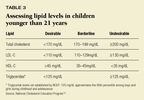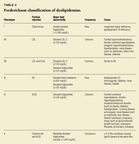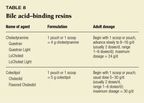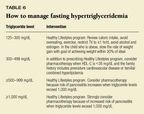Measuring and managing lipid levels
Help your young patients avoid premature cardiovascular disease by knowing when to measure lipid levels, how to interpret them, and what to do about worrisome results.
Measuring and managing lipid levels
By William E. Winter, MD, Dorlinda Varga House, MD, and Desmond Schatz,MD
Help your young patients avoid premature cardiovasculardisease by knowing when to measure lipid levels, how to interpret them,and what to do about worrisome results.
Many studies have shown that atherosclerosis, which leads to cardiovasculardisease, has its roots in childhood.13 If we can anticipatethe premature development of cardiovascular disease, we may be able to preventit.3,4 In adults, every 1 mg/dL decline in total cholesterolleads to a 2% decline in risk of death from coronary artery disease.5For children, the situation is less clear-cut.
Key questions include:
- When should pediatricians measure lipids in children?
- How should pediatricians interpret and manage lipid levels?
- When the low-density lipoprotein cholesterol (LDL-C) is >=130 mg/dL, what further testing or evaluation is indicated?
- How should pediatricians manage LDL-C levels over 130 mg/dL?
- What medications are used to treat pediatric dyslipidemias?
Before addressing these questions, we will review the basic biology oflipoproteins.
Lipoprotein pathways
Triglyceride and cholesterol, the major forms of circulating lipid inthe body, are not soluble in plasma. When packaged with apolipoproteinsand phospholipids as lipoproteins, however, these lipids can be transportedthroughout the body through two major pathways.6 Table 1 identifiesthe five major classes of lipoprotein.

Exogenous pathway.The intestine packages dietary lipids, predominantlytriglycerides, into chylomicrons. The triglyceride-rich chylomicrons enterthe lymph that drains into the thoracic duct. Eventually, the thoracic ductempties into the vena cava and chylomicrons circulate systemically. Onceacted on by lipoprotein lipase, which is attached to the luminal side ofthe capillary endothelium next to muscle and adipose tissue, chylomicronsrelease triglyceride as free fatty acids and monoglycerides. Adipose tissueuses free fatty acids and monoglycerides to resynthesize triglycerides thatare stored in the adipose tissue, and muscle burns these fatty acids andmonoglycerides for energy. These processes result in chylomicron remnants,which the liver rapidly clears. In fasting normal plasma, chylomicrons andchylomicron remnants are absent.
Endogenous pathway. The liver produces very low density lipoprotein (VLDL).Like chylomicrons, VLDL interacts with lipoprotein lipase to release triglyceride-formingintermediate density lipoprotein (IDL) particles. These particles are eitherrapidly removed by the liver or metabolized further to low density lipoprotein(LDL) by continued removal of triglyceride by hepatic lipase. The liverremoves about two thirds of circulating LDL. About one third is removedby extrahepatic tissues, including steroid-producing cells and cells withinthe subintimal space where atheromas--such as atheromatous plaques--develop,causing atherosclerosis. Elevated LDL-C, depressed high-density lipoproteincholesterol (HDL-C), and a high ratio of total cholesterol to HDL-C predictincreased risk for atherosclerosis in adults. Table 2 outlines the risksof hypertriglyceridemia and how to follow up the child with this condition.

When to measure lipids
The National Cholesterol Education Program (NCEP) recommends measuringa child's total cholesterol or doing a lipid profile only under certaincircumstances (see figure).7 Because dietary changes should notbe introduced during infancy, testing before age 2 is not indicated. Testingshould be considered before the child's exercise and eating patterns areestablished, however.

The lipid profile includes total cholesterol, HDL-C, triglycerides, andLDL-C calculated using the Friedewald formula: total cholesterol(HDL-C+ triglycerides/5). The NCEP, the American Academy of Pediatrics, and theAmerican Heart Association do not recommend routine total cholesterol screeningin children; the effectiveness of these guidelinesin preventing cardiovasculardisease is controversial, however.811 Table 3 lists desirableand undesirable fasting lipid levels in children.

Interpreting and managing lipid levels
Measurement of total cholesterol and HDL-C does not require fasting.Isolated triglyceride measurements and lipid profile measurements (whenLDL-C is to be calculated) must be carried out following an overnight fast,however. LDL-C can be calculated with the Friedewald formula when the triglyceridelevel is ¾400 mg/dL. New methods to measure LDL-C directly do not requirefasting specimens; these methods also can be used to determine the LDL-Cwhen the triglyceride level is >=400 mg/dL.
Children should maintain their regular diets for four to six weeks beforetesting. Recent changes in diet that could alter lipid levels are an indicationto delay testing. Severe illness is also a reason to put off testing--forexample, illness requiring hospitalization within the last four to six weeks--becausesignificant stress can temporarily depress lipid levels or cause transientlipid abnormalities such as the hypertriglyceridemia associated with poordiabetes control or diabetic ketoacidosis.
In children whose total cholesterol is <170 mg/dL, no further testingis required for five years.10 The pediatrician should encouragethesechildren and their parents to maintain healthy eating patterns and educatethem about risk reduction. If the total cholesterol is between 170 and 199mg/dL, repeat the test in two to four weeks and average the two values.If the average total cholesterol is <170 mg/dL, diet and exercise educationagain is appropriate. If the average is >=170 mg/dL or the initial totalcholesterol is >=200 mg/dL, obtain a lipid profile.
No further testing is required for five years in the child whose LDL-Cis <110 mg/dL. Instead, provide guidance about healthy eating habitsand risk. When the LDL-C is between 110 and 129 mg/dL, prescribe the StepOne diet developed by the NCEP and reevaluate the child in one year. Thediet calls for:
- ¾30% total fat
- ¾10% saturated fat
- ¾300 mg/day cholesterol, or ¾100 mg/1,000 kilocalories (kcal)
- Carbohydrates about 55% of total calories
- Protein 15% to 20% of total calories.
This diet is safe and does not interfere with growth, and it is easyto make the necessary calculations.12 To estimate total dailycaloric requirements quickly, start with a base of 1,000 calories a dayand add 100 calories for each year of age. A 10-year-old, for example, shouldtake in 2,000 kcal/day: 1,000 kcal/day base plus 10 x 100 kcal/day. If fatmakes up no more than 30% of the calories in this child's diet, fat intakeshould not exceed 600 kcal/day. Fat provides 9 kcal/g; if we round thisto 10 kcal/g, 600 kcal of fat equals approximately 60 g of fat per day.Placing a numeric value on the amount of fat that the child can eat eachday and knowing the number of grams of fat in particular food servings makesit possible (at least in theory) to regulate dietary fat if the child adheresto a specific diet.
High lipid levels and further testing
If a child's average LDL-C is >=130 mg/dL, look for familial dyslipidemiasand secondary causes of dyslipidemia.10 The Frederickson classificationof dyslipidemias (Table 4) is a useful guide. Hyperlipoproteinemia typesI, III, and V are uncommon to rare and do not warrant further discussion.Children with isolated elevations in LDL-C have a Frederickson IIA phenotype.Children with elevations in both LDL-C and triglycerides (>=125 mg/dL)express a Frederickson IIB phenotype. When only triglycerides are elevated,the type IV phenotype predominates. The common IIA and IIB phenotypes areoften associated with familial hypercholesterolemia and familial combinedhyperlipidemia. A family history of these conditions is strongly associatedwith cardiovascular disease.

Familial hypercholesterolemia is an autosomal dominant disorder characterizedby elevated LDL-C with or without a concurrent elevation in triglycerides.The condition strikes about one in 500 individuals in the general population.13LDL-C is elevated in all affected family members; both LDL-C and total cholesterolare elevated in the cord blood of babies with familial hypercholesterolemia.Males with the condition often develop coronary heart disease in their 30sor 40s and women in their 40s or 50s.
Familial combined hyperlipidemia, found in one in 200 to 300 people inthe general population, is also inherited in an autosomal dominant pattern.14Some individuals have isolated elevations in total cholesterol or triglycerides,while others have combined hyperlipidemia (increased LDL-C and triglycerides).Like familial hypercholesterolemia, familial combined hyperlipidemia isassociated with premature coronary heart disease.
When the LDL-C is not greatly elevated and the pattern of inheritanceis unclear, the hypercholesterolemia can be called "polygenic"for lack of a better term, assuming secondary causes of elevated LDL-C havebeen excluded.
To assess family history beyond data obtained in the interview, measurelipids in all first and second degree relatives of the child with dyslipidemia.Findings in relatives who have never been tested before may reveal dyslipidemiathat requires treatment. This information can aid in diagnosing the child.Studies to exclude secondary dyslipidemias include measurement of thyroid-stimulatinghormone to rule out primary hypothyroidism, and tests of liver function(albumin, total bilirubin, alanine aminotransferase [ALT], and alkalinephosphatase) and renal function (urinalysis and levels of sodium, potassium,chloride, carbon dioxide, blood urea nitrogen, and creatinine).
Managing high LDL-C levels
Initial management of hypercholesterolemia combines diet, exercise, andattention to possible secondary causes of the condition. The goal is toachieve an LDL-C level of <110 mg/dL; at a minimum the child should attainan LDL-C level of <130 mg/dL. If levels are not satisfactory after threemonths on the Step One diet, prescribe the Step Two diet. It reduces saturatedfat to ¾7% of total calories and dietary cholesterol to ¾200 mg/day.The child also should engage in regular aerobic exercise and try to maintainan ideal body weight. While weight loss may not be feasible in a growingchild, weight maintenance or slowing the rate of weight gain are reasonablegoals, allowing the child to "grow into his weight." Eliminateor minimize secondary causes of elevated LDL-C by, for example, treatinghypothyroidism or improving glycemic control in diabetes.
The NCEP advises considering pharmacotherapy if six to 12 months of dietaryand exercise interventions have not reduced LDL-C to <160 mg/dL in achild 10 years or older. The NCEP chose 10 years as the earliest usual agefor intervention because autopsy studies of children who died from traumashowed fatty streaks in the coronary arteries of children this age or older.
Table 5 outlines specific indications for medical treatment. Althoughthe NCEP has no recommendations for pharmacotherapy when the elevated lipidsare primarily triglycerides--type IV phenotype--we recommend the strategyshown in Table 6. We believe in initiating pharmacotherapy for childrenwith a family history of premature cardiovascular disease who have a triglyceridelevel of >=300 mg/dL and an HDL-C level of <35 mg/dL.15This is the profile of many of the children referred to us for evaluationand treatment of elevated triglyceride levels.


Medications for treating pediatric dyslipidemias
Table 7 lists the medications used to treat common pediatric dyslipidemias.We also recommend daily multivitamins but not daily aspirin or pharmacologicdoses of b-carotenes, vitamin C, or folate because of a lack of informationabout the effectiveness, or side effects, of such therapy in children. Addingfiber to the diet is certainly benign, and we recognize that fiber can lowertotal cholesterol and LDL-C in adults.

Bile-acid binding resins, or sequestrants, are first-line drugs for treatingtype IIA hyperlipoproteinemia (increased LDL-C).16,17 The powderyresins, cholestyramine and colestipol, are insoluble in water and must bemixed with water or juice to avoid intestinal obstruction. The resins aretaken with meals, when bile acids are secreted. The dose is measured inscoops or packets of 4 to 5 grams each; Table 8 describes adult dosages.A typical approach to dosing in children is to begin with one or two packetsor scoops per day given in orange juice or water with meals. The dosageis divided between breakfast and dinner and increased every month untilLDL-C is below 130 mg/dL or maximum dosage is reached. The unpleasant tasteand grainy consistency of these agents limit their use, however.

Bile-acid binding resins can elevate triglycerides, so they are not indicatedfor the treatment of type IIB hyperlipoproteinemia, in which the triglyceridesare already elevated. The child should not take medications at least onehour before or three hours after consuming bile acid-binding resins becausethese agents bind drugs and vitamins in addition to bile salts. This restrictioncan be a significant problem for children who are being treated for seizuredisorders or asthma, or are receiving immunosuppressive therapy for tissuetransplantation.
Niacin (nicotinic acid) is effective in adults in treating types IIA,IIB, IV, and V hyperlipoproteinemia, and one study describes niacin's effectivenessin children.18 Begin niacin at a dosage of 50 mg/day and increasethe dosage very gradually--every four weeks or at even longer intervals.Continue until the LDL-C is <160 mg/dL (when treating types IIA or IIB)or the triglyceride level is <300 mg/dL (in treating type IV), or untila dosage of 1,500 to 3,000 mg/per square meter of body surface area is reachedwithout liver toxicity. Split the dosage as soon as a dosage of 100 mg/dayis reached. If the LDL-C declines to <130 mg/dL (in types IIA or IIB) or the triglycerides fall to <125 mg/dL (in type IV), consider reducingthe niacin dose or attempting a trial off medication. Table 9 summarizesguidelines for using niacin.

Niacin has potentially significant systemic toxicities, including liverdisease, nausea and gastrointestinal upset, and facial flushing. In adults,glucose intolerance and hyperuricemia have been reported. Flushing may bereduced by taking aspirin, though this can be dangerous for children withviral illnesses. Slow release preparations of niacin, such as Slo-niacin,Niacor, Nicolar, and Niaspan, may be more likely to produce liver toxicitythan regular preparations because higher niacin levels are sustained forlonger periods of time.19 We measure ALT every three months inall children treated with niacin.
HMG-CoA reductase inhibitors. These drugs, which are referred to as "statins,"inhibit 3-hydroxy-3-methylglutaryl coenzyme A reductase (HMG-CoA reductase).This enzyme controls the rate-limiting step in cholesterol biosynthesis.The statins entered clinical practice in the treatment of adults more than10 years ago. The available statins include lovastatin (Mevacor), pravastatin(Pravachol) simvastatin (Zocor), cerivastatin (Baycol), fluvastatin (Lescol),and atorvastatin (Lipitor). Table 10 lists dosages in adults; in children,we initiate treatment with the lowest dosage form available. In lovastatin,for example, this is a 10 mg dosage. Consider dosage increases after sixto 12 weeks initially and every 12 weeks thereafter until the LDL-C is <160mg/dL or, in adolescents, the maximum adult dose is reached without toxicity.

In children, the maximum statin dose must be scaled back in proportionto the child's weight compared with that of an adult. In prepubertal children,for example, we would not exceed a lovastatin dosage of 40 mg/day comparedwith the maximum adult dosage of 80 mg/day. Once the LDL-C is below 160mg/dL, the dose need not be increased further.If the LDL-C drops to <130mg/dL, consider reducing the statin dose or attempting a trial off medication.Various statins have been shown to be very effective and safe in children.2023
Hepatocellular toxicity and rhabdomyolysis, which can cause acute renalfailure, are the major complications of the statins, though frank rhabdomyolysisis rare. The likelihood of rhabdomyolysis increases when a patient takesa statin simultaneously with cyclosporin, gemfibrozil, erythromycin, azoleantifungals, or lipid-lowering doses of niacin.When using statins in adults,according to the Physicians' Desk Reference, aspartate aminotransferaseor ALT should be monitored before beginning therapy, then after six and12 weeks and every six months thereafter. For pravastatin, a slightly lessvigorous monitoring schedule is required: before therapy, after 12 weeks,and 12 weeks after each dosage change. We find it practical to monitor ALTevery three months in children treated with a statin.
Fibric acid derivatives. No data are available on the use of fibric acidderivatives in children. Like niacin, these agents are useful in adultsfor treating various dyslipidemias, including types IIA, IIB, IV, and Vhyperlipoproteinemia. Currently, three fibric acid derivatives are marketed:clofribrate (Atromid-S), gemfibrozil (Lopid), and fenofribrate (TriCor).To treat a type IIA phenotype in children, we recommend using bile-acidbinding resins, niacin, or statins before turning to fibric acid derivatives.When the triglycerides are elevated, however, niacin is the first choice,with gemfibrozil and atorvastatin the next alternatives.
In adults, common toxicities include myalgias, myositis, myopathy, rhabdomyolysis,liver toxicity, gallstones, and glucose intolerance. Gemfibrozil is lesslikely to cause gallstones than clofribrate. The Food and Drug Administration(FDA) approved fenofibrate in 1998; we have only limited experience withusing it in children and adolescents. In our clinic, we monitor ALT everythree months in children treated with gemfibrozil.
Following up. It is our practice to see children with dyslipidemias everythree months. At these visits we obtain an interim history to establishdiet and exercise patterns and explore any symptoms of drug toxicity. Wealso go over the family history to determine if any new information is availableand review vital signs and growth in weight and height. The physical examinationfocuses on potential findings that could indicate a secondary dyslipidemiaor drug toxicity. We usually order laboratory studies two to three weeksbefore the appointment and review them with the patient and his family.
Several alternatives
In the child with type IIA hyperlipidemia, we recommend discussing theadvantages and disadvantages of each agent with the parents. While bile-acidbinding resins have no systemic toxicities, children unfortunately usuallyfind them unpalatable. Nevertheless, a trial of a bile-acid binding resinshould be offered as first-line therapy. If compliance is poor or the LDL-Cremains >160 mg/dL, or declines less than 15% to 20%, offer niacin next.Alternatively, offer niacin if the parents reject the bile-acid bindingresin as first-line therapy. If niacin therapy is rejected or ineffective,suggest a statin. Lovastatin, simvastatin, and pravastatin appear equallyefficacious and safe in children with type IIA hyperlipoproteinemia. Thereare no reports on the use of cerivastatin or fluvastatin in pediatrics.
For types IIB and IV, niacin is first-line treatment. If niacin is ineffectiveor produces unacceptable adverse side effects in type IIB, use gemfibrozilor atorvastatin, which is FDA approved for treatment of combined hyperlipidemia.In type IV, the alternative to niacin is gemfibrozil.
Because the number of children recognized to be at risk for prematurecardiovascular disease is increasing, studies of the safety and efficacyof lipid-lowering drugs inchildren should be greatly expanded.24In the meantime, pediatricians can best serve their patients by knowingwhen to measure lipids and how to interpret the results, and by keepingup with current knowledge about when and how to lower lipid levels. Thepediatrician who is unaccustomed to prescribing and monitoring hypolipidemicdrugs should consider referring to a pediatric lipid specialist the childwhose condition may warrant these agents.
DR. WINTER is Professor, Departments of Pathology, Immunology, and LaboratoryMedicine; Pediatrics; and Molecular Genetics and Microbiology and MedicalDirector and Section Chief, Clinical Chemistry, University of Florida, Gainesville.
DR. HOUSE is Courtesy Clinical Assistant Professor of Pathology, PediatricEndocrine and Diabetes Specialists of Central Florida, Lake Mary.
DR. SCHATZ is Associate Professor of Pediatrics, University of Florida,Gainesville.
REFERENCES
1. Strong JP, McGill HC: The pediatric aspects of atherosclerosis. JAthero Res 1969;9:251-65
2. Pathobiological determinants of atherosclerosis in youth (PDAY) ResearchGroup: Relationship of atherosclerosis in young men to serum lipoproteincholesterol concentrations and smoking. JAMA 1990;264:3018
3. Strong JP, Malcom GT, McMahan CA et al: Prevalence and extent of atherosclerosisin adolescents and young adults: Implications for prevention from the PathobiologicalDeterminants of Atherosclerosis in Youth study. JAMA 1999;281:727
4. Lauer RM, Clarke WR: Use of cholesterol measurements in childhoodfor the prediction of adult hypercholesterolemia. JAMA 1990;264:3034
5. Expert Panel on Detection, Evaluation, and Treatment of High BloodCholesterol in Adults: Summary of the second report of the National CholesterolEducation Program (NCEP) expert panel on detection, evaluation, and treatmentof high blood cholesterol in adults (Adult Treatment Panel II). JAMA 1993;269(23):3015
6. Stein EA, Myers GL: Lipids, lipoproteins, and apoproteins, in CA Burtisand ER Ashwood (eds): Tietz Textbook of Clinical Chemistry, Philadelphia,PA, WB Saunders, 1994
7.Newman TB, Brower WS, Hulley SB: Childhood cholesterol screening: Contraindicated.JAMA 1992;267:100
8. Committee on Nutrition: Indications for cholesterol testing in children.Pediatrics 1989;83:141
9. Committee on Atherosclerosis and Hypertension in Childhood of theCouncil on Cardiovascular Disease in the Young and the Nutrition Committee,American Heart Association: Diagnosis and treatment of primary hyperlipiderniain childhood. Circulation 1986;74:1181A
10. National Cholesterol Education Program Expert Panel on Blood CholesterolLevels in Children and Adolescents: Report of the expert panel on bloodcholesterol levels in children and adolescents. Washington, DC, US Departmentof Health and Human Services NIH Publication No. 91-2732, 1991
11. Stare TJ, Belamarich PF, Shea S, et al: Family history fails to identifymany children with severe hypercholesterolernia. Am J Dis Child 1991;145:61
12. The Writing Group for the DISC Collaborative Research Study Group:Efficacy and safety of lowering dietary intake of fat and cholesterol inchildren with elevated low-density lipoprotein cholesterol. JAMA 1995 273:1429
13. Kuo PT: Dyslipidemia and coronary artery disease. Clin Cardiol 1994;17:519
14. Cortner JA, Coates PM, Liacouras CA, et al: Familial combined hyperlipidemiain children: Clinical expression, metabolic defects, and management. CurrProbl Pediatr 1994;24:295
15. Nikkila M, Koivula T, Niemela K, et al: High density lipoproteincholesterol and triglycerides as markers of angiographically assessed coronaryartery disease. Br Heart J 1990;63(2):78
16. Tonstad S, Knuatzan J: Efficacy and safety of cholestyramine therapyin peripubertal and prepubertal children familial hypercholesterolemia.J Pediatr 1996;129:42
17. McCrindle BW, O'Neill BO, Cullen-Dean G, et al: Acceptability andcompliance with two forms of cholestyramine in the treatment of hypercholesterolemiain children: A randomized, crossover trial. J Pediatr 1997;130:266
18.Colletti RR, Neufeld EJ, Roff NK, et al: Niacin treatment of hypercholesterolemiain children. Pediatrics 1993;92:78
19. McKenney JM, Proctor JD, Harris S, et al: A comparison of the effacacyand toxic effects of sustained- vs. immediate-release niacin in hypercholesterolemicpatients. JAMA 1994;271:672
20. Sinzinger H, Schmid P, Pirich C, et al: Treatment of Hypercholesterolaemiain children. Lancet 1992;340:548
21. Lambert M, Lupien PJ, Gagne C, et al: Treatment of familial hypercholesterolemiain children and adolescents: Effect of lovastatin. Pediatrics 1996;97:619
22. Dubocu J, Brasseur D, Chaudron JM, et al: Simvastatin use in children.Lancet 1992;339:1488
23. Knipscheer HC, Boelen CA, Kastelein JP, et al: Short-term efficacyand safety of pravastatin in 72 children with familial hypercholesterolemia.Pediatr Res 1996;39:867
24. Tonstad S: A rational approach to treating hypercholesterolemia inchildren. Drug Therapy 1997;16:330